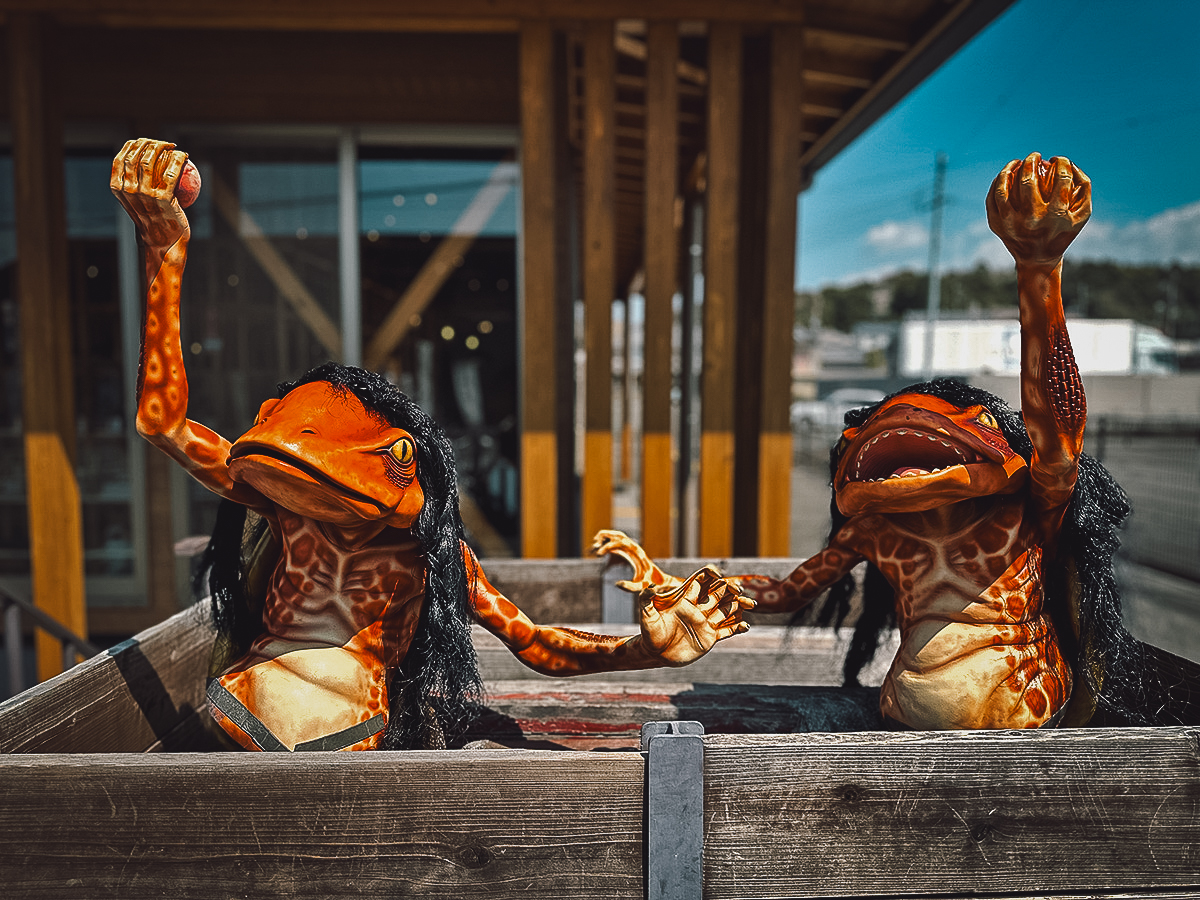SUMMARY HIGHLIGHTS
- You can search for the yokai benches on foot, by bicyle/e-bike, or by yokai gaji pod.
- You can easily visit Himeji Castle and Fukusaki on the same day.
I didn’t know this before visiting Fukusaki, but apparently, I have a mythical ball-shaped organ inside my anus called a shirikodama.
According to Japanese folklore, you should be careful when swimming in lakes because a mischievous yokai called a kappa may drag you underwater and pull out your shirikodama[1]. If it does, it’ll cost you your soul, even your life, since the shirikodama is believed to contain your vital life force or spirit energy.
Thankfully, the kappa didn’t steal my shirikodama. Instead, it taught me about shogi and expressed its love for Sumo wrestling and cucumbers. Interestingly, I learned that the kappa’s weakness for cucumbers is why cucumber sushi rolls are known as “kappa maki” in Japanese![2]
Fukusaki has become known as “the town where you can encounter yokai”[3], and this quirky, cucumber-loving creature is one of many colorful yokai you’ll meet when you visit.
VISIT FUKUSAKI QUICK LINKS
To help you plan your trip to Fukusaki, I’ve put together links to transportation and other travel-related services here.
RAIL PASSES
OTHER SERVICES
TRAVELING TO FUKUSAKI
Fukusaki is a small city in Hyogo Prefecture, less than half an hour north of Himeji. To get there, take the JR West Bantan Line from Himeji Station to Fukusaki Station. If you have a Kansai Wide Area Pass or a nationwide JR Pass, then you can use it to travel to Fukusaki.
Shortly after exiting the train station, you’ll be welcomed by this mechanical kappa. It rises up from the bottom of this water-filled chamber at 7 minutes, 22 minutes, 37 minutes, and 52 minutes past the hour between 7:07AM and 8:07PM daily.
You’ll encounter many yokai in Fukusaki but the kappa apears to be the Pikachu of the yokai universe in this town.
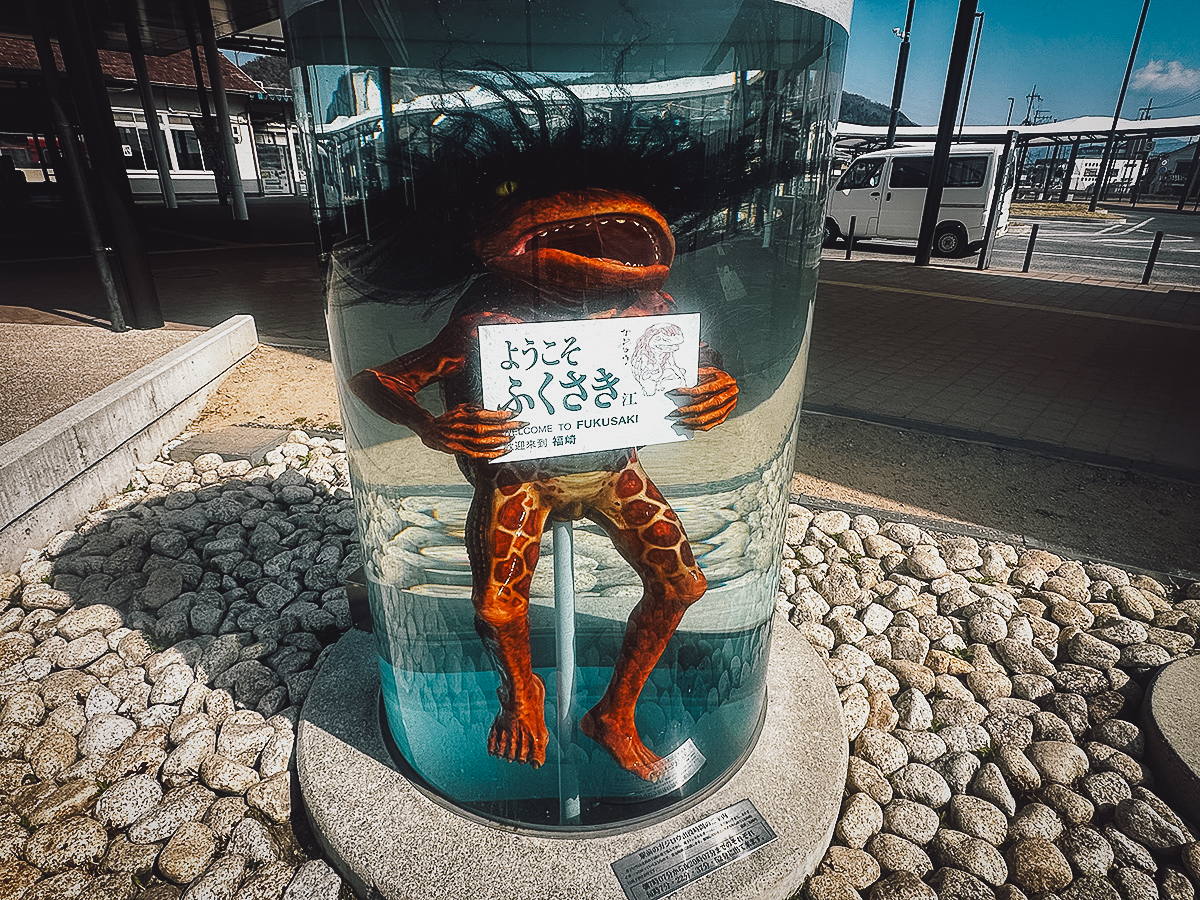
WHAT ARE YOKAI?
In Japanese folklore, the term “yokai” refers to a broad class of supernatural beings and phenomena like monsters, ghosts, demons, and spirits. The word comes from the kanji yo, meaning attractive or bewitching, and kai, which means mystery or wonder[4].
Yokai have been a part of Japanese culture for centuries. In ancient Japan, spirits were thought to be formless, but as artistic traditions developed, so did the need to visually depict the supernatural beings from stories. The Edo Period saw an unprecedented flourishing of art and culture in Japan, and with it came the surge in popularity of yokai[4].
Yokai fell out of fashion during the Meiji Restoration, but they’ve experienced a resurgence since World War II, thanks to the massive success of Shigeru Mizuki’s manga series GeGeGe no Kitaro[4]. Today, the influence of yokai can be seen in various forms throughout pop culture, from anime and manga to video games, branding, and film.
WHY ARE THERE YOKAI IN FUKUSAKI?
Fukusaki is linked to yokai because it’s the birthplace of Kunio Yanagita (1875-1962), the Japanese author and scholar often hailed as the father of Japanese folklore studies. He was one of the first scholars to gather and transform Japan’s folk traditions, myths, and legends – including stories about yokai – into literary works.
Yanagita’s work helped preserve these stories at a time when Japan was rapidly modernizing and oral traditions were disappearing. Folk legends weren’t being shared the way they used to, so he wrote books in the hopes of preserving these stories for younger generations[3].
To honor his legacy, this small city of less than 20,000 people[5] has embraced yokai as part of its cultural identity. You’ll find a statue of Kunio Yanagita at Fukusaki’s Tsujikawayama Park, close to his childhood home which the author once described as “the smallest in Japan”[3].
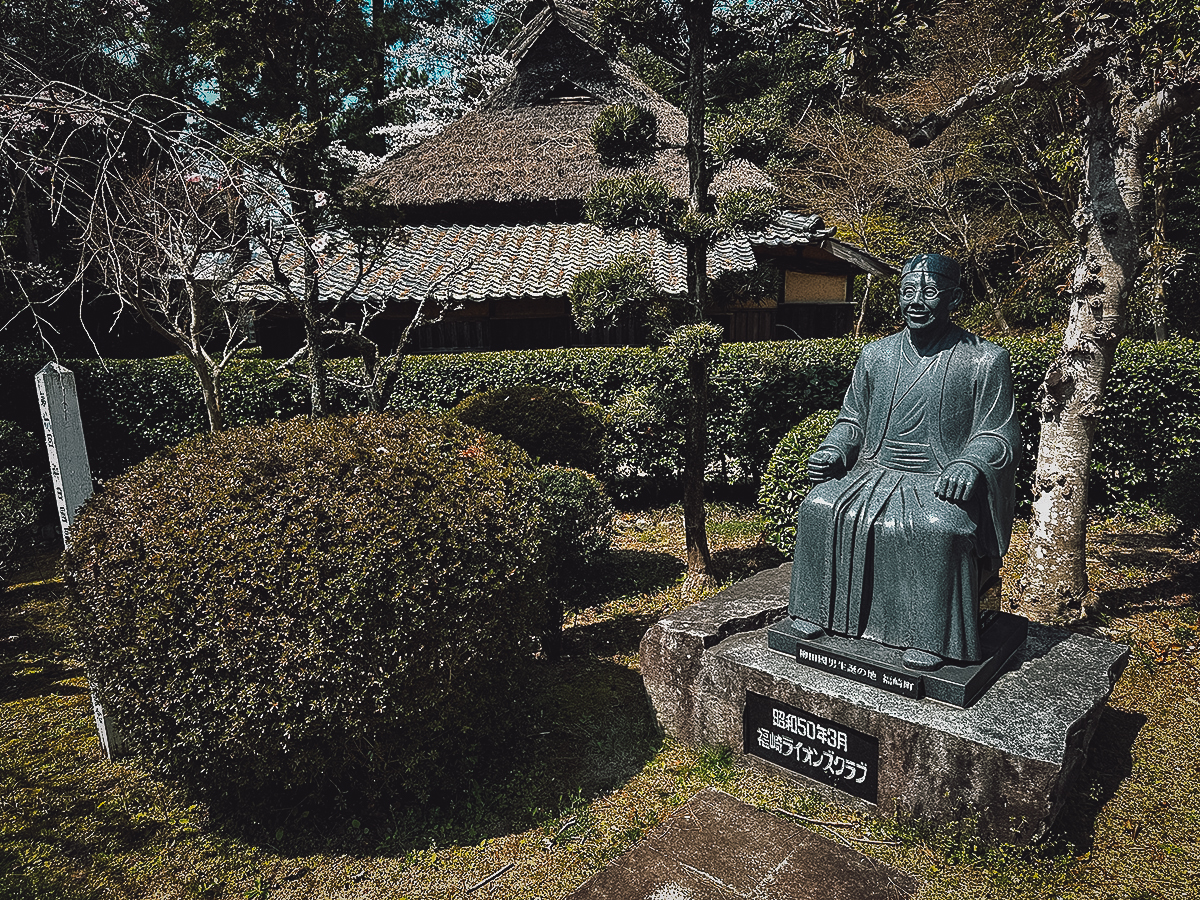
This is Kunio Yanagita’s childhood home. The author once wrote, “My house is the smallest in Japan”. He added, “Indeed, it can be said that my passion for folklore studies was born from the destiny of living in this tiny house”[3].
Though small, Yanagita’s home is said to be typical of Japanese farmhouses from that era. I don’t know if they allow visitors inside but the house was closed at the time of my visit.
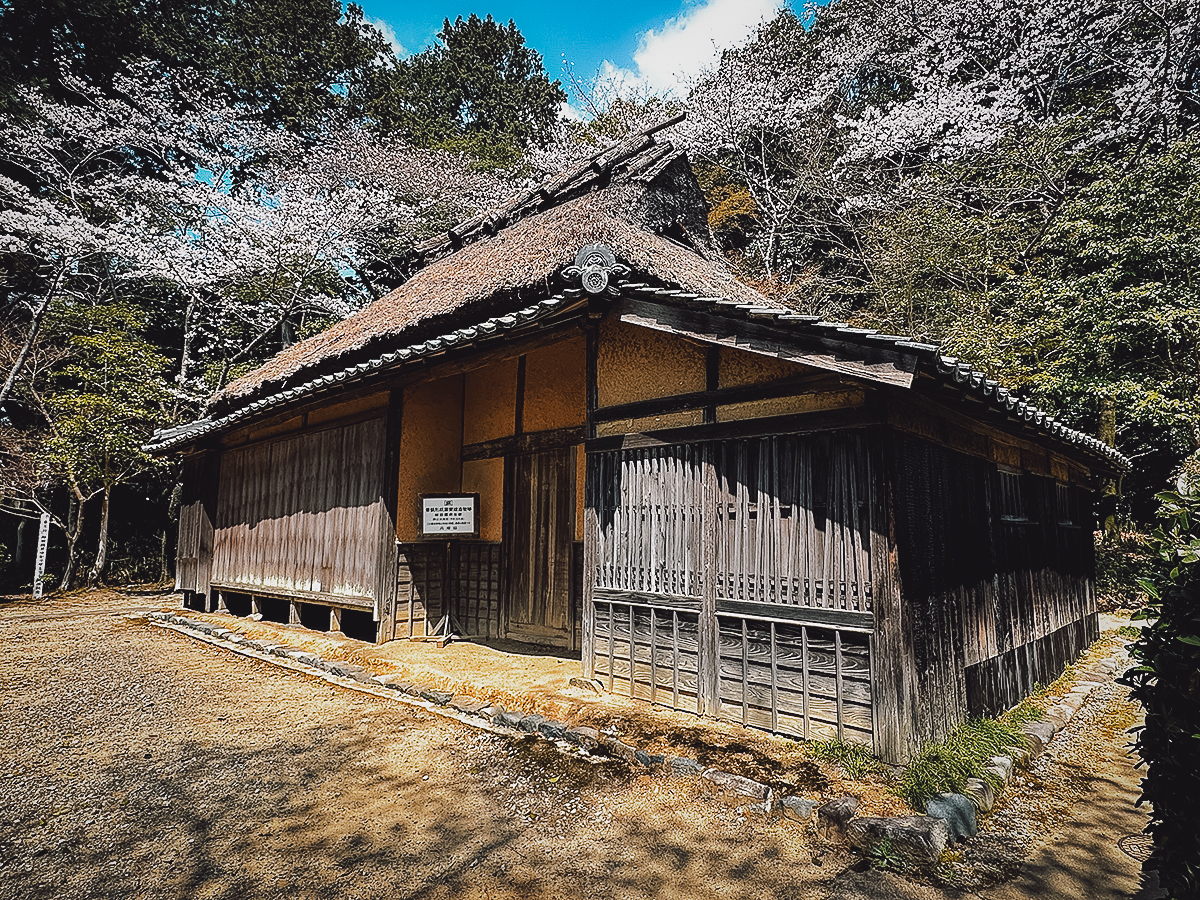
TSUJIKAWAYAMA PARK
In an effort to attract more tourists while celebrating Kunio Yanagita’s legacy, Fukusaki began erecting various yokai sculptures around town. Fittingly, they started at Tsujikawayama Park, near Yanagita’s childhood home[3].
Pictured below is a statue of Gataro the kappa holding two shirikodama. According to legend, he and his brother Gajiro would drag children into the pond to steal their shirikodama.
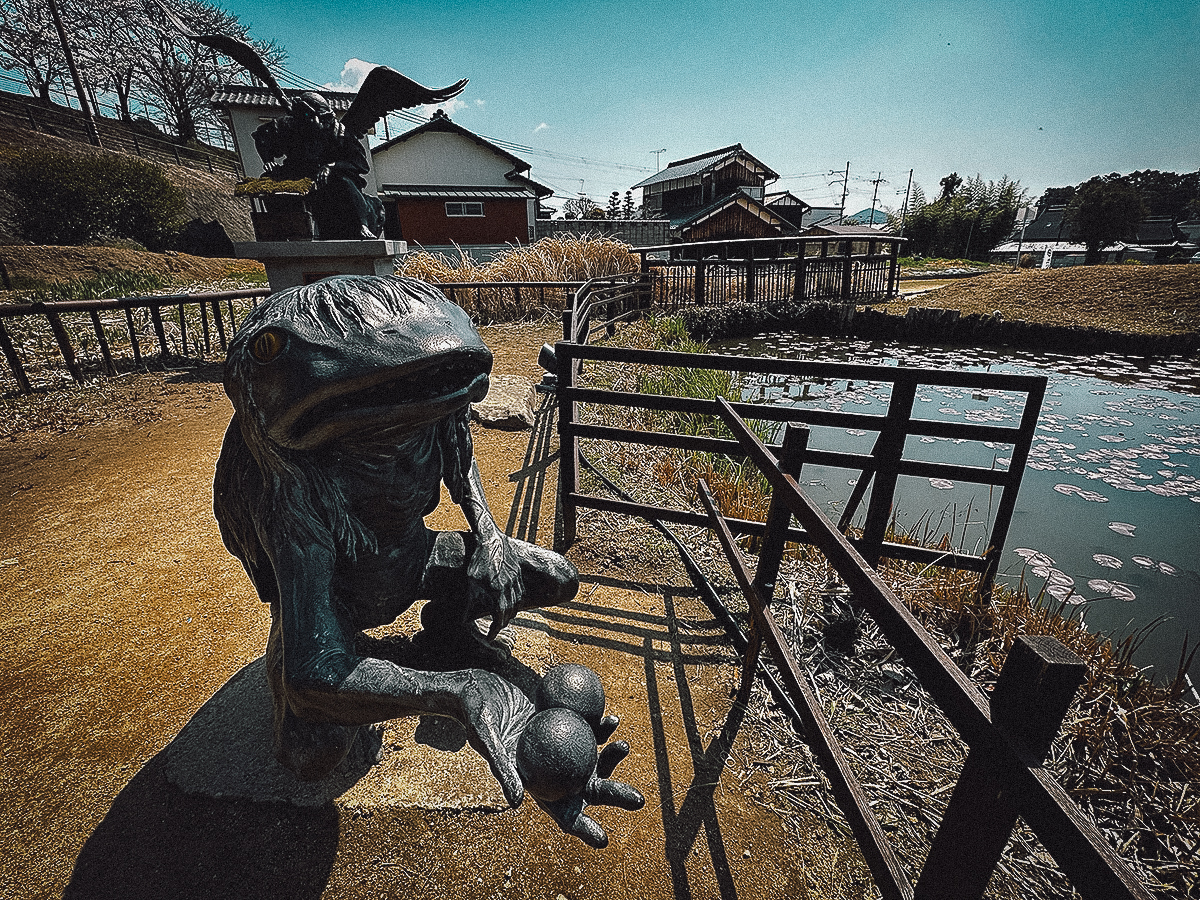
Remember that red kappa in the water-filled chamber outside Fukusaki Station? This is supposed to be that same kappa. Rising from the pond’s murky depths at 0 minutes, 15 minutes, 30 minutes, and 45 minutes past the hour, he spends his days swimming between Tsujikawayama Park and Fukusaki Station.
This is Gajiro, Gataro’s brother. He’s covered in algae right now, but park staff would paddle out to him in a boat from time to time and clean him off. Like the version at Fukusaki Station, he’s usually redder in color.
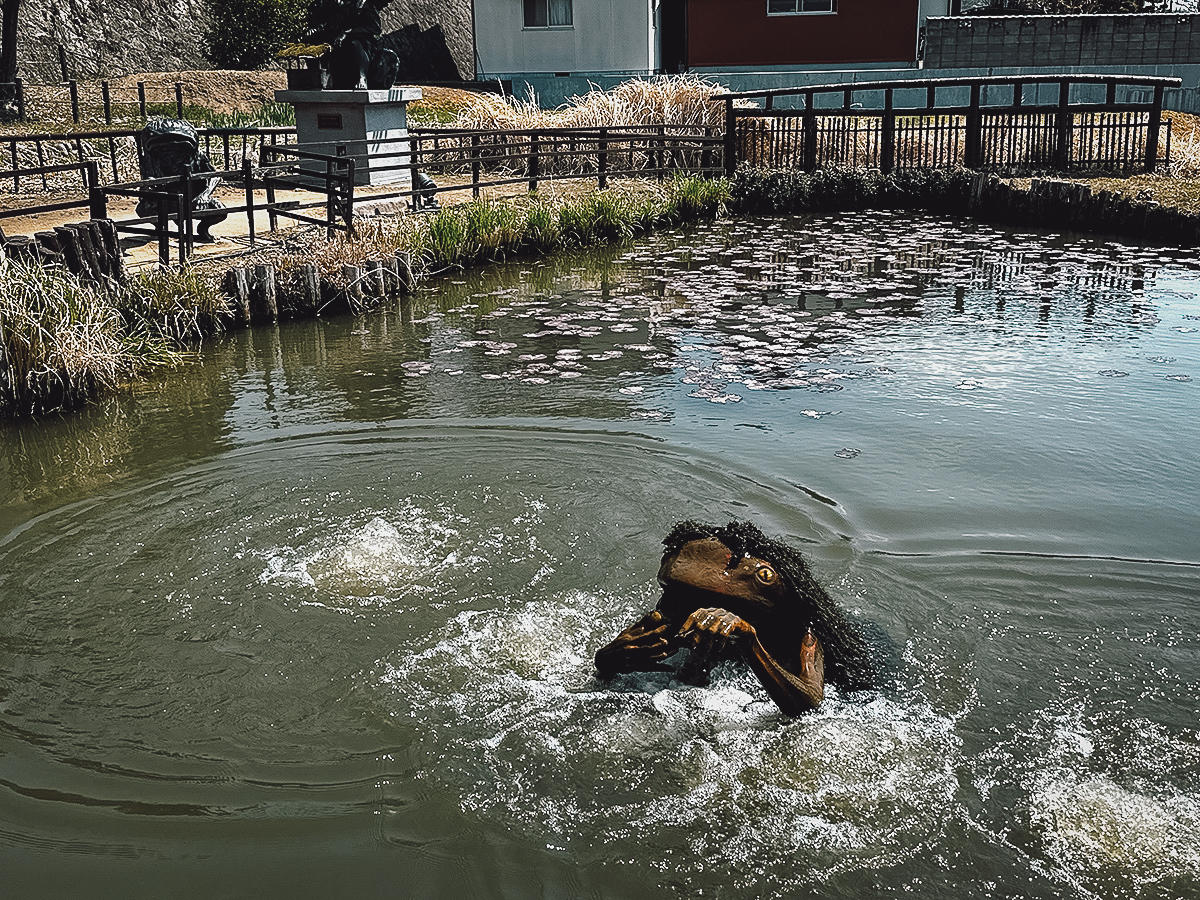
Of all the mechanized yokai in Fukusaki, this inverted tengu is the most eye-catching. At 5 minutes, 20 minutes, 35 minutes, and 50 minutes past the hour between 9:05AM and 6:05PM, he’d emerge from his shack, float over the park for a few minutes, then vanish again.
Tengu are mountain yokai with a weakness for dorayaki – a pancake sandwich filled with sweet red bean paste. You can see this tengu holding one in his right hand.
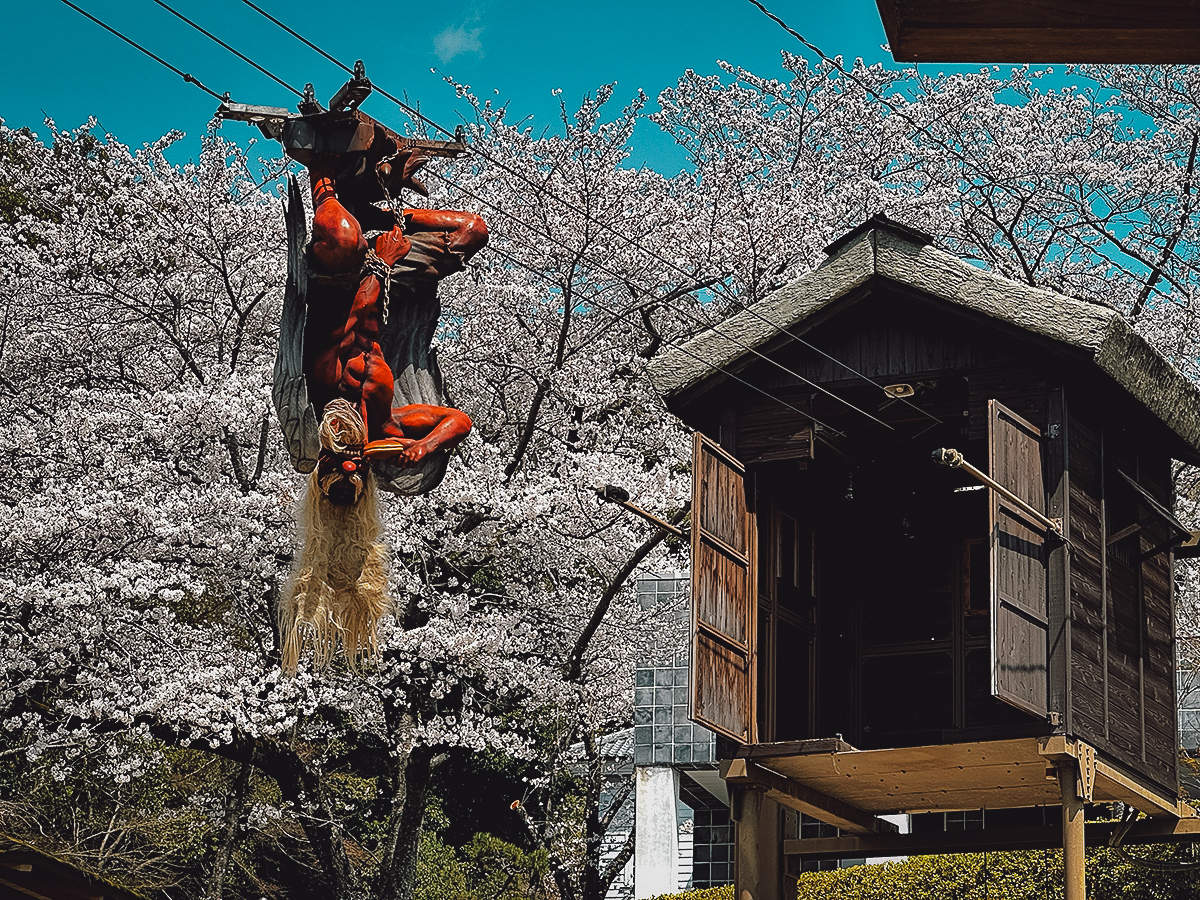
This beautifully detailed kappa slide looks like it’s a fairly new addition to the park. According to a 2024 article from the Asahi Shimbun, it’s said to have cost 9 million yen to produce[6].
Fukusaki is taking the initiative to boost its tourism numbers by promoting itself as a destination for yokai. Clearly, it’s working. The town received over 700,000 visitors in 2023, up from less than 300,000 when the yokai redevelopment project first began in 2013[6].
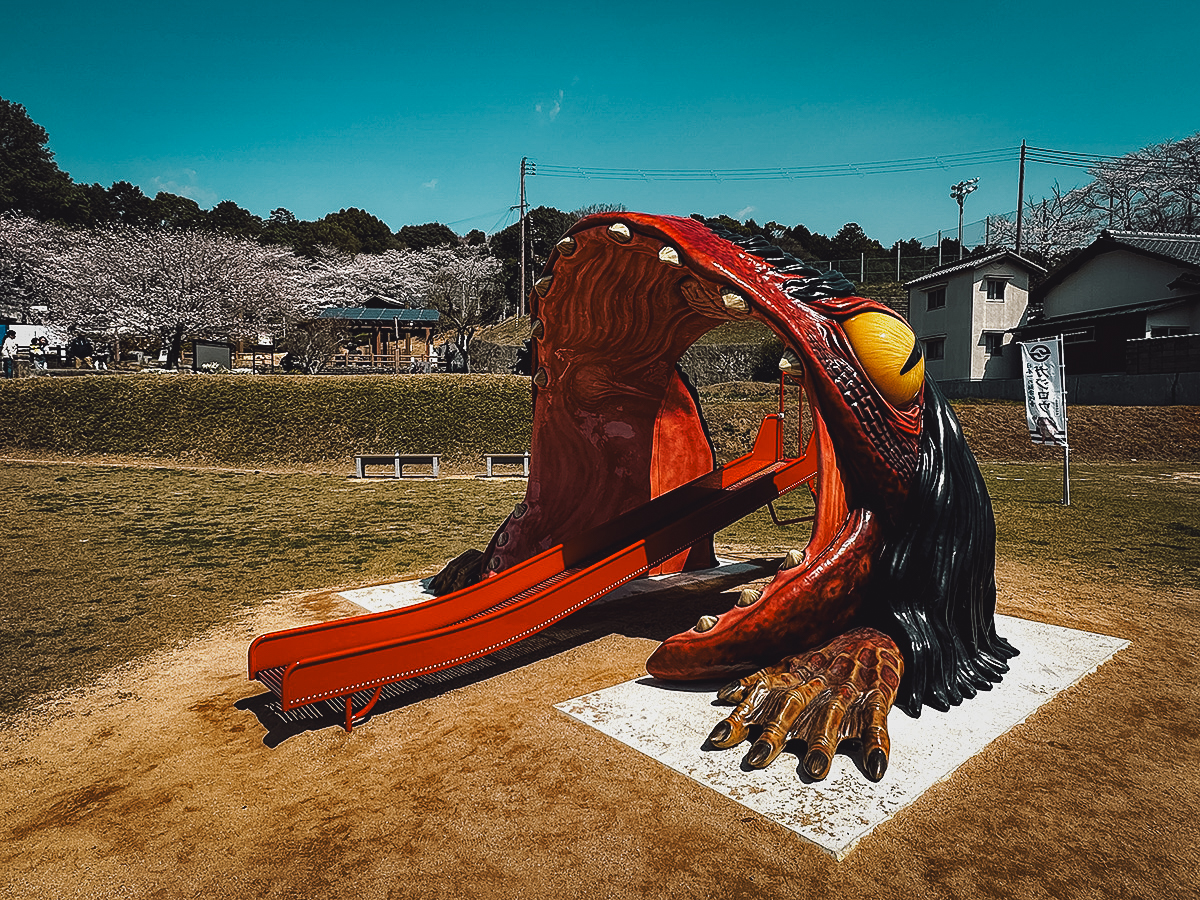
YOKAI BENCH SEARCH MAP
The mechanized yokai at Fukusaki Station and Tsujikawayama Park are impressive, but seeking out the yokai benches is the most fun. Hidden throughout town, they put you on a yokai scavenger hunt while simultaneously promoting the various businesses around town. More on that in the next section of this article.
After arriving at Fukusaki Station, I highly recommend making a quick stop at the Tourist Information Center right next to the station. You can pick up a free illustrated map showing you the location of all yokai benches. As of April 2025, there are twenty-two benches hidden in different spots around town, but the city plans to produce a total of fifty[7].
To be honest, this illustrated map is cute but it’s really more of a souvenir. This interactive yokai map with GPS is much easier to use. Not only will it lead you to every yokai bench, but it’ll point you to other places of interest around town like restaurants, shops, and other tourist attractions.
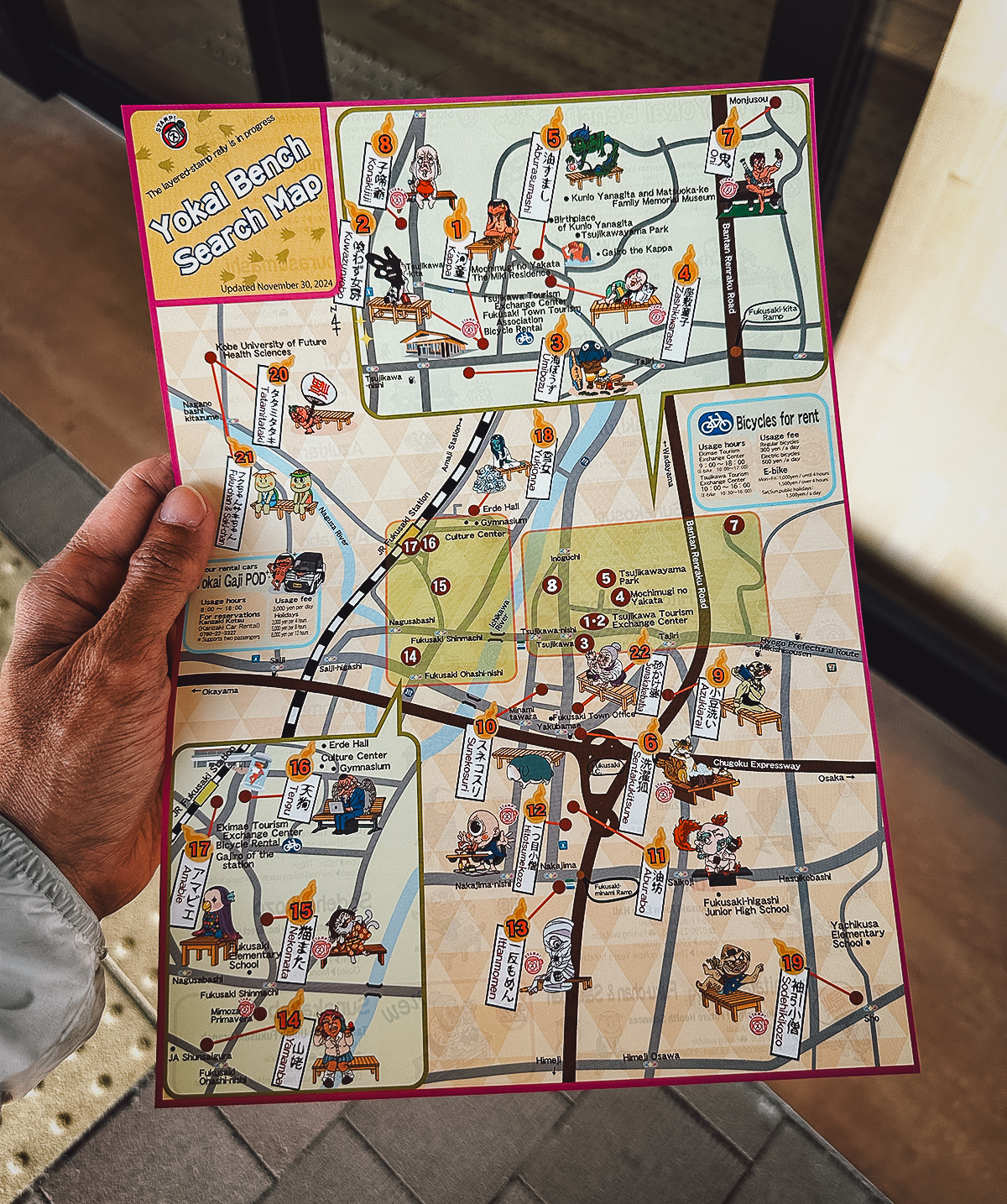
Now that you have your map, it’s time to search for the yokai! There are a few ways you can do that.
On Foot
This is what I did. I found eighteen of the twenty-two yokai on foot. If I really wanted to, I could have walked to the nineteenth, but the last three were a little too far to get to on foot.
Fukusaki is small but not that small, so it’ll probably take the average person between 2-3 hours to walk to the nineteen yokai benches located in the central part of town.
By Bicycle / E-bike
This is probably the easiest and most fun way of looking for the yokai benches. You can rent a bicycle or e-bike from either of the two tourism offices in town (Ekimae Kankokoryu Center | Tsujikawa Tourism Exchange Center).
Depending on what type of bike you get, rental rates range between 300 and 1,500 yen per day (April 2025).
By Yokai Gaji Pod
If you’d like to search for the yokai benches in style, then you may want to rent a Yokai Gaji Pod. Customized with kappa decals, they’re cute two-seater electric cars that go no faster than 60 kph (37.3 mph)[8].
Reservations for Yokai Gaji Pods need to be made in advance through Kanzaki Kotsu. Tap on the link for rental rates.
THE YOKAI BENCHES OF FUKUSAKI
When you look at these pictures, it becomes obvious why they’re called “yokai benches”. The statues are affixed to benches so visitors can sit and take selfies with them. #iseewhatyoudidtherefukusaki
Finding and seeing what they look like is half the fun so I won’t show them all to you, but here are a few of my favorites. This one is called a yamauba (or yamanba, yamamba), a mountain-dwelling yokai that takes the form of an old woman. She’s said to devour anyone she encounters on mountain paths.
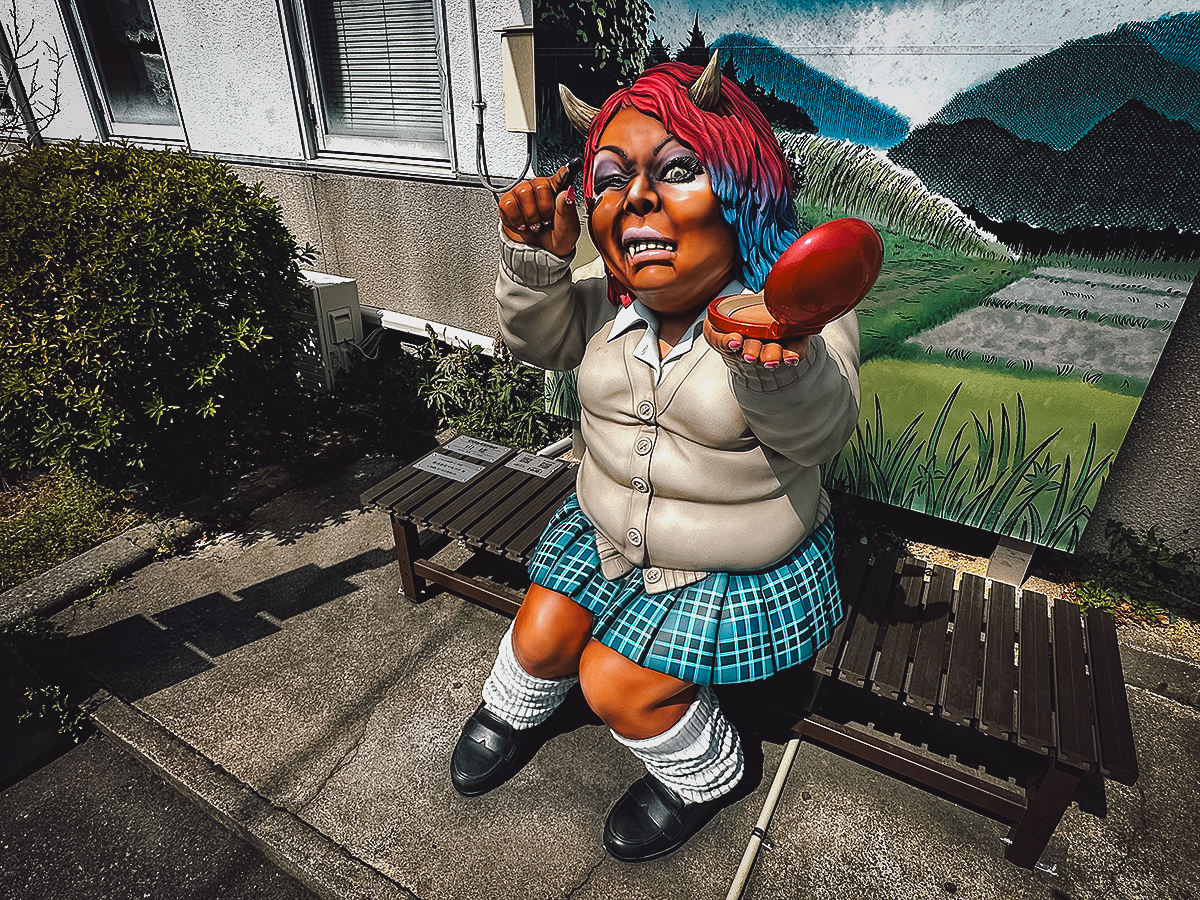
On every bench is a QR code that you can scan to learn about each yokai. All the yokai on these benches are based on the works of Kunio Yanagita[3].
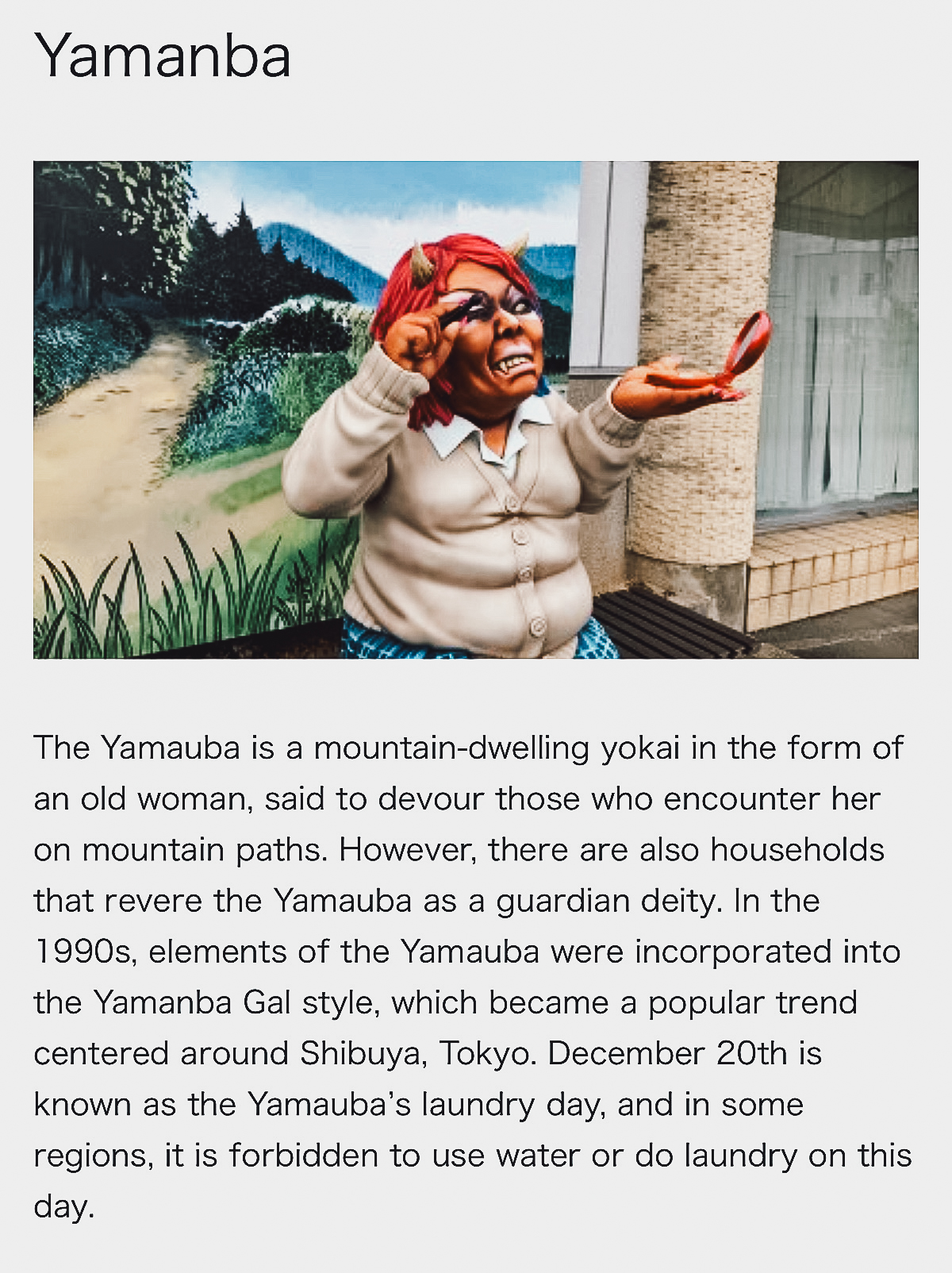
This big baby is a konaki-jiji, a crying old man with the body of an infant. It lures people by crying on the side of dark roads. When you pick it up, it gradually gets heavier and heavier until it crushes you.
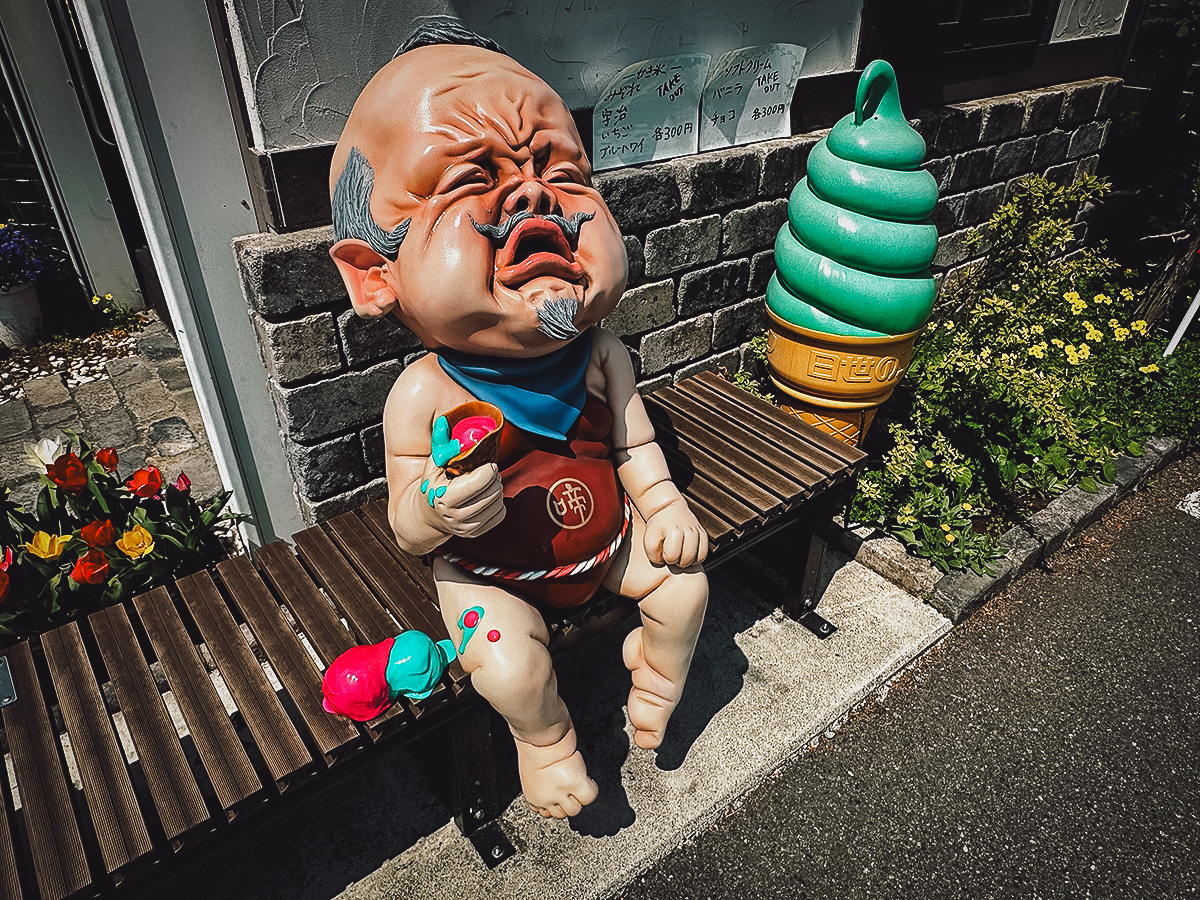
This old woman is the newest yokai bench in Fukusaki. It’s a sunakake-babaa, a yokai that frightens people by throwing sand at them.
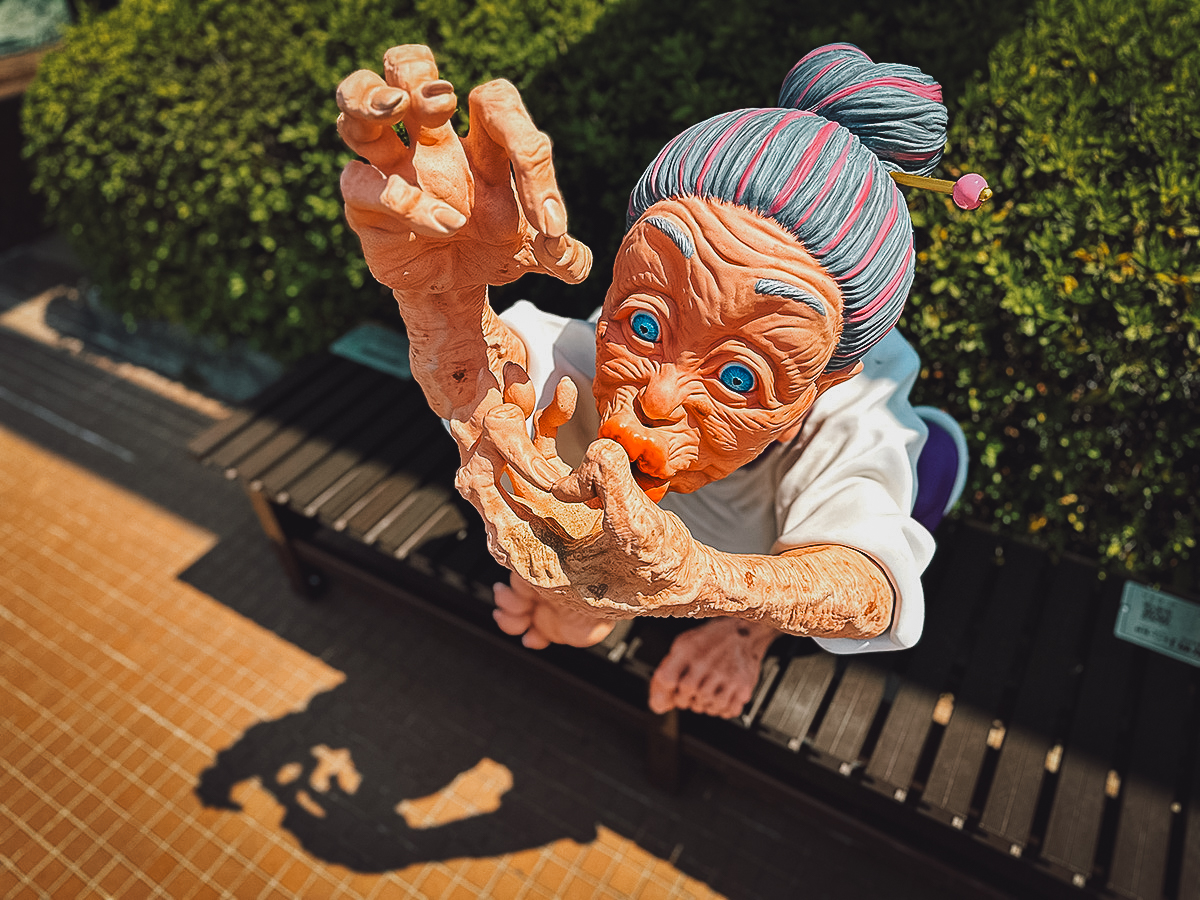
This fire-breathing gent is an abura-bou. In olden times, oil was a rare and precious commodity extracted from plants and fish. Stealing or mishandling it was considered a grave crime, so anyone who did so was transformed into an abura-bou.
Fittingly, this yokai bench was strategically placed in front of a yakiniku restaurant. Many of these yokai benches are placed in front of small businesses like restaurants, cafes, meat shops, and supermarkets. Not only do they teach you about yokai, but they encourage visitors to patronize the town’s various business as well. Brilliant!
The strategy worked with me. I stopped at a fantastic kaitenzushi restaurant for lunch thanks to a sendakakitsune (mythical fox doing laundry) that led me to it.
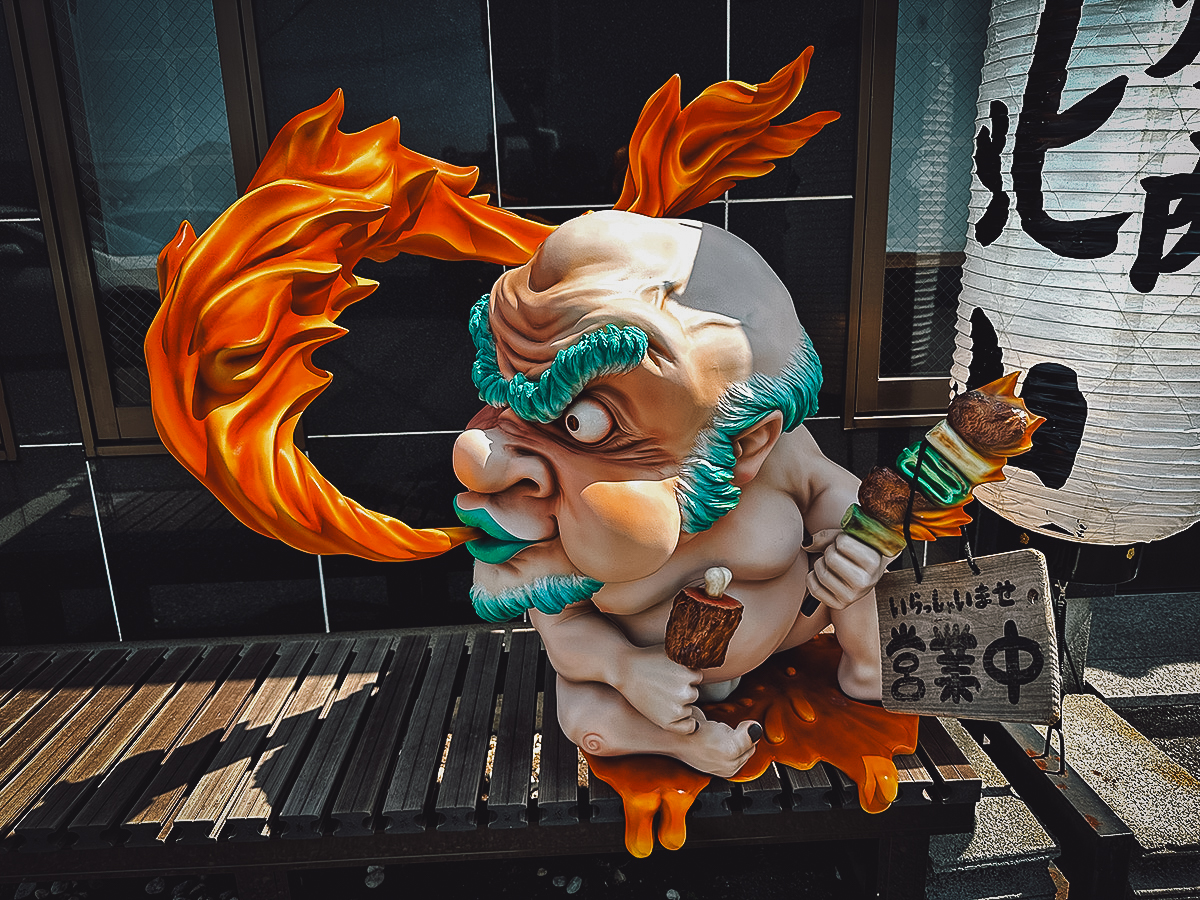
This mischievous yokai is known as an azukiarai (red bean washer). They lure people into the river with the sound of azuki beans being washed in the water.
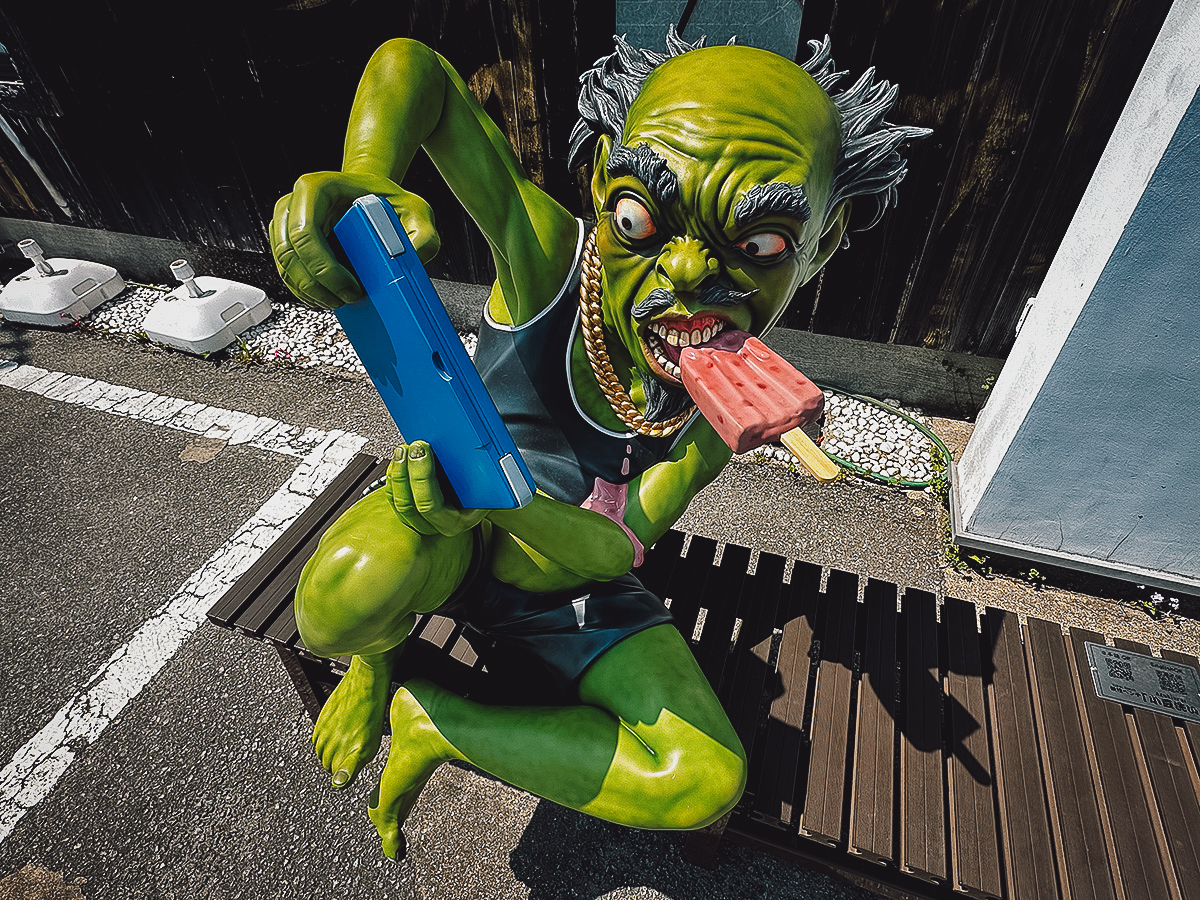
Known as a kuwazu-nyoubou, this pretty yokai may look harmless but she hides a frightening secret. I won’t ruin the surprise but look at her from the back and you’ll see what it is.
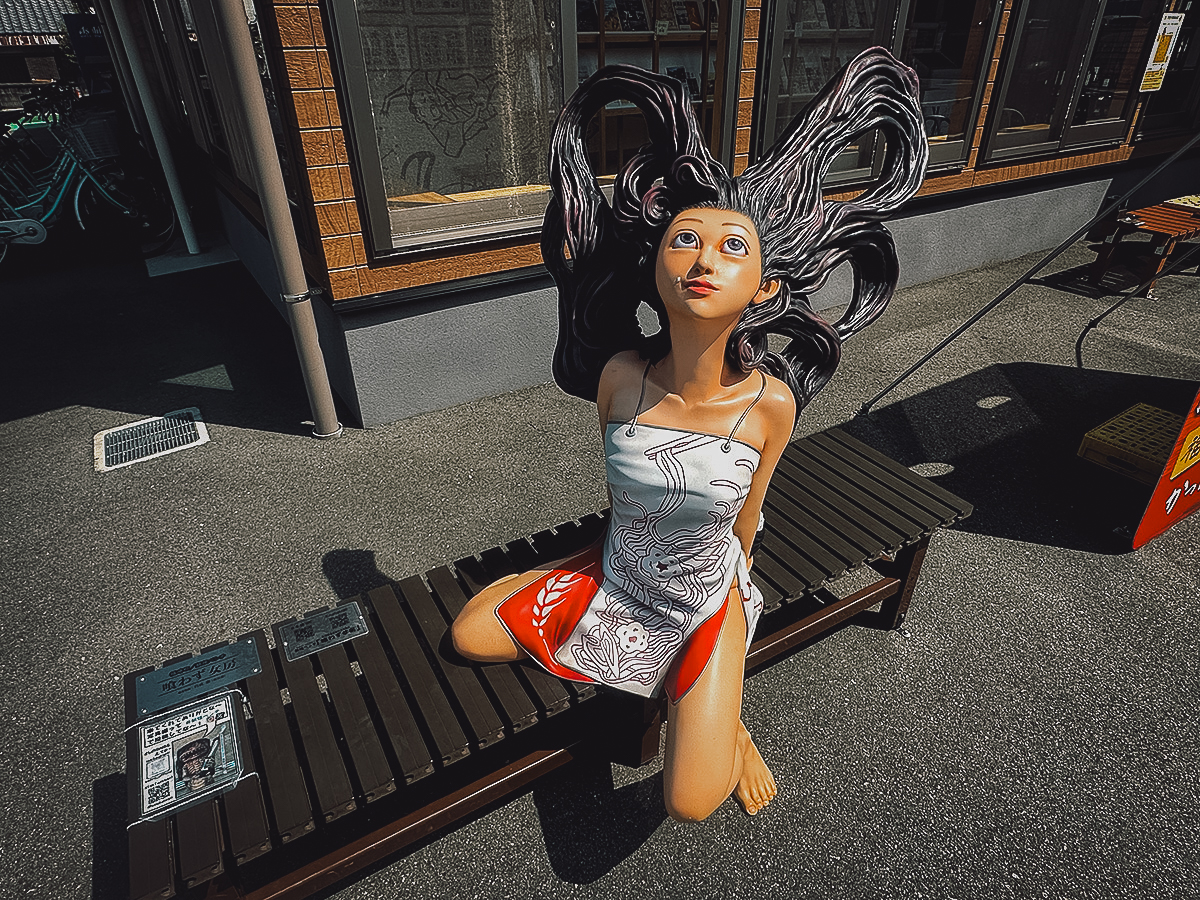
LAYERED STAMP RALLY
Japan is all about these commemorative stamps and Fukusaki has come out with one of the coolest.
Like the daruma stamp rally at Katsuoji in Osaka, it’s a layered stamp that requires guests to visit multiple stamping stations around town. Each stamp contains a small part of the image so you’ll need to get all seven stamps to complete the picture.
The free illustrated map from the tourism office tells you which yokai benches have these stamping stations. You can refer to this article on Fukusaki’s layered stamp rally for more information.
VISIT FUKUSAKI FAQs
Is Fukusaki worth visiting?
Yes, but only if you’re into this sort of thing. Fukusaki doesn’t have a lot of tourist attractions, so you’ll be going just for the yokai. If you’re into things like Pokemon, then that’s reason enough to visit.
Can I search for the yokai benches on foot?
Yes. Some of the yokai are too far to get to on foot but the vast majority are located within the city center.
Is it worth spending the night in Fukusaki?
No, I don’t think so. There simply isn’t enough in Fukusaki to merit an overnight stay.
Can I visit Himeji Castle and Fukusaki on the same day?
Yes, absolutely. In fact, it makes sense to visit them on the same day trip from Osaka or Kobe. Himeji Castle can be explored in 2-3 hours so you can visit the castle in the morning before going yokai hunting in Fukusaki in the afternoon.
THE FINAL SAY
In ancient times, yokai were viewed mostly as mischievous or malevolent creatures but today, it’s common to portray them in cute and appealing ways, like mascots. I wanted a souvenir to remind me of my visit, and I couldn’t have asked for a cuter memento than this yokai gachapon.
Available at the tourism office, the gachapon gods gave me this one-eyed yokai called hitotsume-kozou. It enjoys dressing up like a monk and startling people. Kawaii!
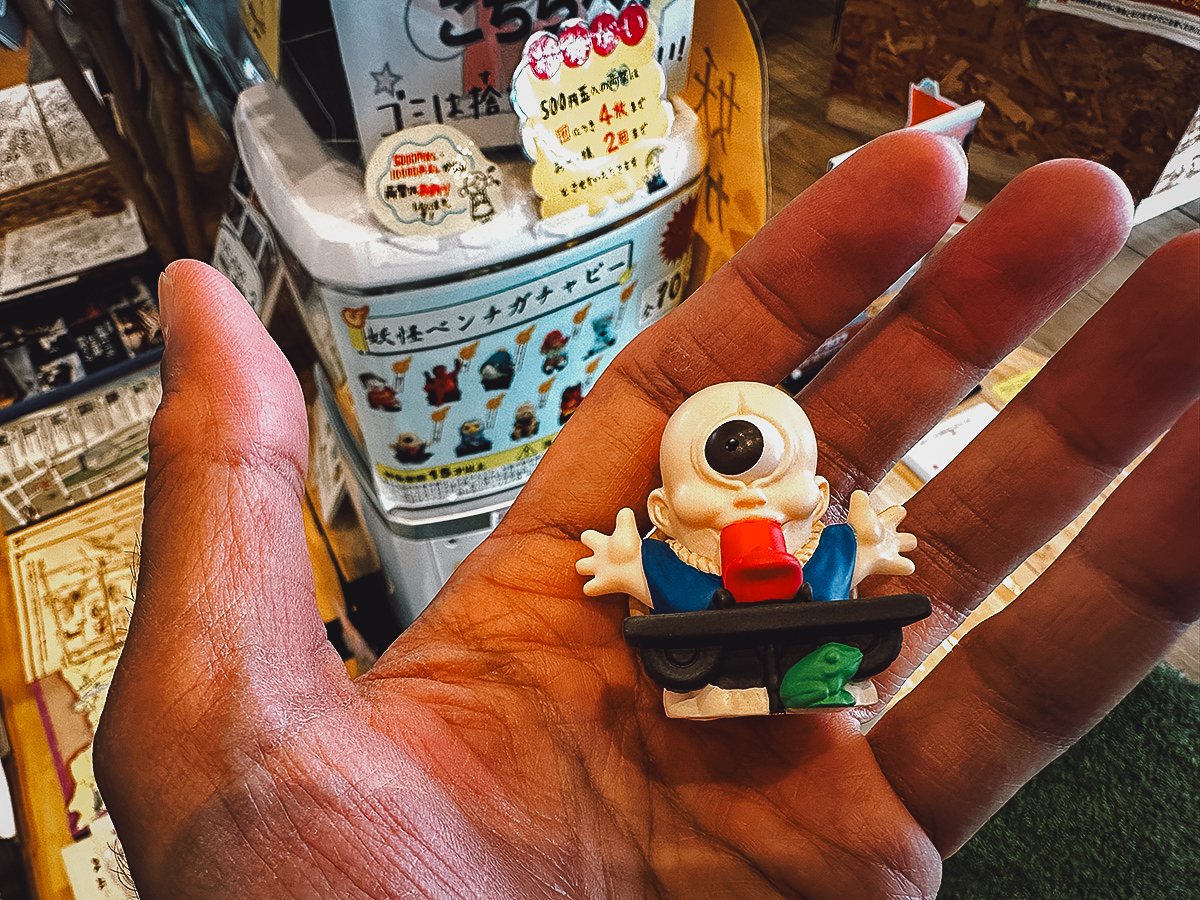
Disclosure
This article on Fukusaki’s yokai contains affiliate links, meaning we’ll earn a small commission if you make a booking or purchase at no extra cost to you. As always, we only recommend products and services that we use ourselves and firmly believe in. We really appreciate your support as this helps us make more of these free travel guides. Arigato gozaimasu!
References
1. Davisson, Zack (2012, January 25). Kappa to Shirikodama – Kappa and the Small Anus Ball, 百物語怪談会 Hyakumonogatari Kaidankai.
2. Kappa maki (かっぱ巻き). Food in Japan. (2023, October 27).
3. Minami, Kristina (2024, March 27). Escape from Himeji: Discover Fukusaki’s Folklore, Historic Hotel, and Local Delights, Amazing Hyogo Japan.
4. Introduction to Yōkai. Yokai.com. (2013, May 31).
5. Fukusaki, Hyōgo. Wikipedia. (2004, April 1).
6. Amemiya, Toru (2024, June 23). Hyogo town hits tourism jackpot with ‘yokai’ attractions, The Asahi Shimbun.
7. Ueki, Yoshikazu (2019, October 4). Tourists Come for the Monsters of Fukusaki, Japan Forward.
8. Rental car with ‘creepy-cool’ monster design hits the streets in west Japan town. The Mainichi. (2022, October 27).

